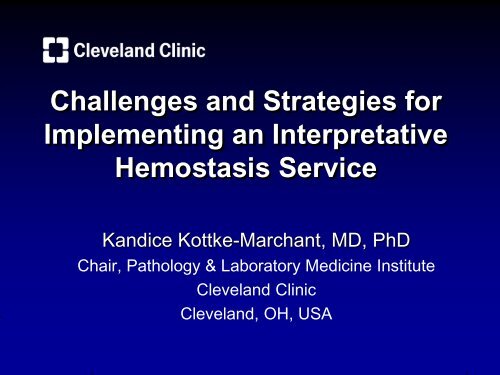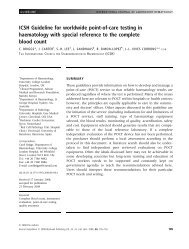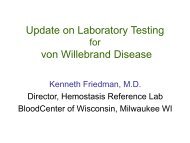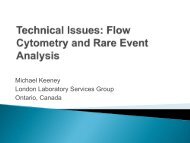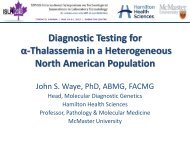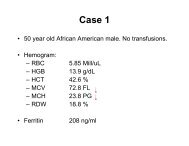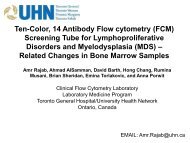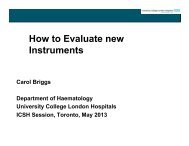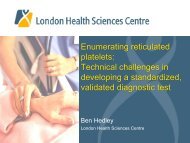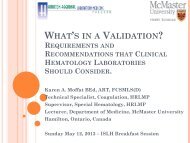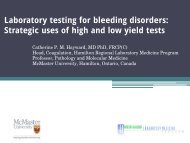Laboratory Testing
Laboratory Testing
Laboratory Testing
Create successful ePaper yourself
Turn your PDF publications into a flip-book with our unique Google optimized e-Paper software.
Challenges and Strategies for<br />
Implementing an Interpretative<br />
Hemostasis Service<br />
Kandice Kottke-Marchant, MD, PhD<br />
Chair, Pathology & <strong>Laboratory</strong> Medicine Institute<br />
Cleveland Clinic<br />
Cleveland, OH, USA
<strong>Laboratory</strong> <strong>Testing</strong><br />
Test<br />
Result<br />
Factory?<br />
OR<br />
Diagnostic<br />
Information<br />
Service?
Healthcare Reform<br />
• Value-based delivery system<br />
• Value = Quality or Benefit / Cost<br />
• <strong>Laboratory</strong> <strong>Testing</strong> IS good value now<br />
- Benefit (70% of medical decisions based<br />
on testing)<br />
- Cost (Lab testing only 2% CMS charges)
<strong>Laboratory</strong> <strong>Testing</strong><br />
Progression<br />
Patient<br />
Visit<br />
Dr Orders<br />
Test<br />
Sample<br />
Collected<br />
When is a Pathologist’s<br />
Consultation Helpful?<br />
Test<br />
Result<br />
Available<br />
Dr<br />
Interprets<br />
Test<br />
Dr<br />
Treats<br />
Patient<br />
Pre-Pre-Analytic<br />
Analytic Phase<br />
(Test Performed)<br />
Post-Post-Analytic<br />
Pre-Analytic<br />
Laposata M. Clin Chem Lab Med 2007;45:712<br />
Post-Analytic
Rapidly Increasing Medical<br />
Knowledge<br />
• 20,000+ medical journals<br />
• DRG’s thousands<br />
• Test menu<br />
- Cleveland Clinic 2600 tests<br />
• Number of drugs increasing<br />
• McGlynn study<br />
- 6712 adults in 12 metropolitan areas<br />
Increasing<br />
Interpretation<br />
complexity<br />
- Evaluated 439 indicators of quality care<br />
- 54.9% subjects received recommended<br />
care<br />
- Only 61.7% received correct laboratory<br />
tests Mcglynn EA, et al. N Eng J Med 2003; 348:2635
Unique Issues with Hemostasis<br />
<strong>Testing</strong><br />
• Test selection<br />
• Population-based reference range<br />
• Sample collection issues (hemolysis, fill<br />
volume, correct anticoagulant)<br />
• Interfering drugs (heparin, DTI, anti-Xa)<br />
• Sample transport – time, temperature<br />
• Sample processing – delays, centrifuge,<br />
aliquot<br />
• Storage – freezing, thawing<br />
• <strong>Testing</strong> – best methodology,<br />
functional/antigen assay
<strong>Laboratory</strong> Value Focus<br />
Patient<br />
Visit<br />
Dr Orders<br />
Test<br />
Sample<br />
Collected<br />
Current Value<br />
Focus:<br />
Pre-analytic errors<br />
(labeling, lost sample,<br />
incorrect collection)<br />
Efficient test<br />
performance<br />
(Lean and Six Sigma)<br />
Correct reporting<br />
Test<br />
Result<br />
Available<br />
Dr<br />
Interprets<br />
Test<br />
Dr<br />
Treats<br />
Patient<br />
Pre-Pre-Analytic<br />
Analytic Phase<br />
(Test Performed)<br />
Post-Post-Analytic<br />
Pre-Analytic<br />
Laposata M. Clin Chem Lab Med 2007;45:712<br />
Post-Analytic
New <strong>Laboratory</strong> Value Focus<br />
Patient<br />
Visit<br />
Dr Orders<br />
Test<br />
Sample<br />
Collected<br />
Future Quality<br />
Focus:<br />
Pre-pre analytic errors<br />
(order the correct<br />
test)<br />
Post-post analytic<br />
errors<br />
(Test interpretation)<br />
Test<br />
Result<br />
Available<br />
Dr<br />
Interprets<br />
Test<br />
Dr<br />
Treats<br />
Patient<br />
Pre-Pre-Analytic<br />
Analytic Phase<br />
(Test Performed)<br />
Post-Post-Analytic<br />
Pre-Analytic<br />
Laposata M. Clin Chem Lab Med 2007;45:712<br />
Post-Analytic
What Does Increased Value Look<br />
Like on the Hemostasis Service?<br />
• Beyond result and reference range<br />
• Identify High Hct – False h PT, APTT<br />
• Identify preanalytic issues – short draw,<br />
clotted sample, hemolyzed<br />
• Identify interfering drugs – heparin, DTI<br />
• Use algorithms to diagnose bleeding<br />
disorders and thrombophilia risk<br />
• Interpret results with clinical and<br />
medication history
Evaluation of an Elevated APTT<br />
Order Repeat APTT<br />
Analyze<br />
Results<br />
Order More<br />
<strong>Testing</strong><br />
Results: Bleeding<br />
Risk (YES/NO)<br />
+/- Therapy<br />
Perform <strong>Testing</strong><br />
Perform <strong>Testing</strong><br />
Surgery
What are the Elements of an<br />
Interpretive Hemostasis Service?<br />
• “Goal-oriented” test ordering<br />
• Package or battery of initial tests<br />
• Additional testing based on an algorithm<br />
• Assesses interfering drugs, alternate<br />
reasons for test abnormalities, clinical<br />
history, summarizes results<br />
• Reports an interpretation of results,<br />
indicating cause and significance of the<br />
coagulation abnormality
Why Offer an Interpretive<br />
Hemostasis Service?<br />
• Evaluate coagulation abnormalities more<br />
efficiently<br />
• Streamline testing type and cost<br />
• Decrease sample volume<br />
• More rapid results<br />
• Exclude interfering drugs<br />
• Provides physician with an interpretation<br />
and estimation of bleeding risk or<br />
recommendation for therapy
How does it work?<br />
Order Elevated APTT<br />
Panel<br />
Perform Initial<br />
<strong>Testing</strong><br />
(PT, APTT, Mixing)<br />
Additional<br />
Tests<br />
Are Added<br />
per<br />
Algorithm<br />
Freeze<br />
Aliquots<br />
-80 o C<br />
Tabulate<br />
Pertinent<br />
Clinical<br />
Data and<br />
Medication<br />
History<br />
Pathologist<br />
And Resident<br />
Review All Cases<br />
3 times per day<br />
Develop Interpretive<br />
Report<br />
(Discuss with Physician)<br />
Results: Bleeding<br />
Risk (YES/NO)<br />
+/- Therapy<br />
Surgery
What are the Elements?<br />
• Defined order sets<br />
• Algorithm for reflex testing; MEC approval<br />
• Freeze plasma in individual aliquots; track<br />
• Pathologist/hematologist with coagulation<br />
expertise (residents)<br />
• Clinical and medication history; EMR<br />
• Established interpretations for algorithm<br />
• Mechanism for reporting text reports<br />
• Close communication with clinicians
Algorithm for a Prolonged aPTT<br />
“Remove” Heparin<br />
Hepadsorb<br />
Hepzyme<br />
Polybrene<br />
Recheck aPTT<br />
Recheck TT or anti-Xa<br />
NL<br />
STOP<br />
+<br />
Normal PT<br />
Prolonged aPTT<br />
?Heparin<br />
Do TT or anti-Xa<br />
Negative<br />
Do Incubated<br />
1:1 Mixing<br />
Study<br />
Check Hct<br />
If Hct >55%, draw<br />
With adjusted citrate<br />
& repeat aPTT<br />
CAUTION:<br />
NL anti-Xa and Abn TT<br />
Indicates Direct Thrombin<br />
Inhibitor (DTI Drug)<br />
Cannot “neutralize”<br />
Will affect mixing studies,<br />
Factor assays.<br />
STOP Analysis
Algorithm for a Prolonged aPTT<br />
Incubated Mixing Study<br />
1:1 Mix+<br />
Immediate<br />
Acting<br />
Inhibitor<br />
(Probable<br />
Lupus<br />
Anticoagulant)<br />
Lupus<br />
Anticoagulant<br />
<strong>Testing</strong><br />
1:1 Mix+<br />
Delayed<br />
Acting<br />
Inhibitor<br />
(Probable<br />
Factor<br />
Inhibitor)<br />
Factor Assays<br />
(VIII, IX, XI, XII)<br />
Titer Inhibitor - Bethesda Assay<br />
1:1 Mix<br />
Negative<br />
(Probable<br />
Factor<br />
Deficiency)<br />
Factor Assays<br />
(VIII, IX, XI, XII)
Algorithm for a Prolonged aPTT<br />
1:1 Mix Negative<br />
(Probable Factor Deficiency)<br />
Factor Assays<br />
(VIII, IX, XI, XII)<br />
Only<br />
FVIII<br />
Low<br />
Only<br />
FIX<br />
Low<br />
FXI or<br />
FXII<br />
Low<br />
More than<br />
One Factor<br />
Low<br />
DO: Ristocetin<br />
Cofactor & VWF<br />
Hemophilia A (M)<br />
Carrier State (F)<br />
OR<br />
Von Willebrand<br />
DO: II,VII,X<br />
Hemophilia B (M)<br />
Carrier State (F)<br />
Vit K Deficiency<br />
OR<br />
Warfarin Rx<br />
FXI Deficiency<br />
FXII Deficiency<br />
OR<br />
Carrier States<br />
DO: D-dimer<br />
Fibrinogen<br />
DIC<br />
OR<br />
Hepatic
Developing the Interpretive<br />
Report<br />
• Use of “Coded Comments”<br />
• 150 comments that encompass all decision<br />
points of the aPTT algorithm; 757 total codes<br />
• These codes can be pieced together to render a<br />
patient-specific interpretation<br />
• Codes entered into interpretive Middleware –<br />
translated as text in report - LIS to EMR<br />
(reported with lab results)<br />
• Offers flexibility and consistency in reporting
APTT Incubated Mixing Study:<br />
Interpretive Middleware
APTT Incubated Mixing Study:<br />
Interpretive Middleware
Benefits of Interpretive<br />
Middleware<br />
• Allows standard workflow of interpretations<br />
• Readily displays prior lab results; LIS interface<br />
• Highlights abnormal results<br />
• Standardizes coded comments (757 Codes)<br />
• Allows algorithmic approach to interpretation<br />
• Allows residents to enter preliminary comments<br />
• Allows formatting and customization of<br />
comments<br />
• Standard codes can be edited; Use of free text<br />
• Expedites signout – Rapid interface to EMR<br />
- no need for tech entry of comments
Issues with Interpretive<br />
Middleware<br />
• Workflow complexity<br />
• Not a part of LIS<br />
• Need for IT support<br />
• Results have to be validated in LIS to<br />
appear in Middleware<br />
• Does not connect with billing system<br />
• Down time procedure needed (manual)
What other laboratory tests can<br />
this be applied to?<br />
• Other bleeding disorders: von Willebrand<br />
disease<br />
• Thrombophilia and Lupus Anticoagulant<br />
• Molecular Coagulation Tests<br />
• Platelet Function Tests and Aggregation<br />
• Anemia<br />
• Monoclonal Protein Analysis<br />
• Hemoglobinopathies<br />
• Toxicology<br />
• Thyroid disease<br />
• Liver function testing<br />
• hyperlipidemia
Hypercoagulation <strong>Testing</strong> Algorithm<br />
Add<br />
2GPI<br />
Ab<br />
YES<br />
Follow Fibrinogen<br />
algorithm<br />
(Reptilase, TT,<br />
Imm Fib)<br />
Follow VIII,<br />
Fibrinogen,<br />
CRP algorithm<br />
Follow Protein<br />
C algorithm<br />
Follow Protein<br />
S algorithm<br />
Follow APC-R<br />
algorithm<br />
(Factor V<br />
Leiden may be<br />
performed)<br />
ACA IgG<br />
or IgM >20?<br />
Decreased?<br />
One or more<br />
Elevated?<br />
Decreased?<br />
Decreased?<br />
Decreased?<br />
NO<br />
PT<br />
APTT<br />
STACLOT<br />
Anticardiolipin Ab<br />
Fibrinogen<br />
Factor VIII<br />
CRP<br />
Protein C Functional<br />
Protein S Functional<br />
Antithrombin Functional<br />
APC Resistance<br />
Prothrombin G20210A<br />
Plasma Homocysteine<br />
Abnormal?<br />
YES<br />
Do Heparin<br />
Anti-Xa Assay<br />
Hypercoagulation Panel<br />
Interpretive Middleware
Hypercoagulation Panel<br />
Interpretive Middleware
Roll-Out of Interpretive<br />
Service<br />
Date Panel Complexity Avg #/Mo<br />
June 2011 TEG Low 195<br />
August 2011 Asp/Clo, PFA-100 Low 250<br />
April 2012 Platelet Agg; HIT Med 40<br />
April 2012 VWF Panel High 64<br />
June 2012 Lupus AC Panels High 244<br />
June 2012<br />
Mixing studies, Elevated<br />
PT / aPTT panels<br />
High 80<br />
June 2012 Hypercoagulation Panels Very High 249<br />
March 2013 Molecular Coagulation High 400<br />
Dedicated IT analyst; 350+ emails; weekly meetings<br />
Training for 10 coag techs, residents, 4 staff
Billing for the Interpretation<br />
• Result is patient-specific<br />
• Test results are correlated with clinical condition<br />
• Diagnosis and/or recommendation<br />
demonstrating clinical judgment is provided to<br />
the physician<br />
• The interpretation is signed by the pathologist<br />
(MD, not resident)<br />
• The result is filed in the patient’s medical record<br />
MacMillan DH, et al. AJCP 2001;116 (Suppl 1):S129
<strong>Laboratory</strong> Interpretation Codes<br />
• Code Description<br />
• 86320-26 Immunoelectrophoresis, serum<br />
• 86325-26 Immunoelectorphoresis, other fluids<br />
• 86327-26 Immunoelectrophoresis, 2-dimensional<br />
• 86334-26 Immunofixation eleectrophoresis<br />
• 87162-26 Darkfield examination, any source<br />
• 87207-26 Smear, primary source, for inclusion bodies/parasites<br />
• 88371-26 protein analysis by Western blot, interpretation<br />
• 88372-26 protein analysis by Western blot, with probe, interpretation<br />
• 89060-26 Crystal identification by light microscopy<br />
• 83020-26 hemoglobin, electrophoresis<br />
• 83912-26 Nucleic acid probe<br />
• 84165-26 protein, electrophoretic fraction and quantitation<br />
• 84181-26 Western blot interpretation<br />
• 86390-26<br />
report<br />
Fibrinolysis or coagulopathy screen interpretation and<br />
• 85576-26 Platelet aggregation (in vitro), each agent<br />
• 86255-26 Fluorescent antibody, screen, each antibody<br />
• 86256-26 fluorescent antibody, titer, each antibody<br />
• 83912-26 Molecular diagnostics, interpretation and report<br />
• 80500 CP Consultation, limited<br />
• 80502 CP Consultation; comprehensive
Impact of Hemostasis Diagnostic<br />
Reports<br />
Cleveland Clinic Survey 2010<br />
• Impact Differential Dx 89.6%<br />
• Shorten Time to Dx 73.3%<br />
• Prevent Mis-diagnosis 89.3%<br />
• Avoid Hospital Admission 26.3%<br />
• Reduce Length of Stay 33.3%<br />
N=113<br />
Did the inte rp re ta tio ns le a d to the fo llo wing while ma king a<br />
d ia g no sis?<br />
120<br />
100<br />
80<br />
60<br />
40<br />
Yes<br />
No<br />
20<br />
0<br />
Reduce the number of<br />
laboratory tests required<br />
Reduce the use of<br />
procedures<br />
Change in medications or<br />
blood products<br />
administered<br />
K Kottke-Marchant, L Yerian, J Rogers
How he lp ful ha ve yo u fo und the fo llo wing co a g ula tio n p a ne ls in<br />
imp ro ving yo ur o ve ra ll d ia g no stic p ro ce ss?<br />
Platelet flow cytometry panel<br />
Platelet aggregation panel<br />
Elevated PT panel<br />
Elevated PT/PTT panel<br />
Elevated PTT panel<br />
Von Willebrand panel<br />
Hypercoagulation panel<br />
Lupus anticoagulant panel<br />
0.00 0.50 1.00 1.50 2.00 2.50 3.00 3.50<br />
K Kottke-Marchant, L Yerian, J Rogers
How sa tisfie d a re yo u with the curre nt turna ro und time to re ce ive<br />
the p a tho lo g y inte rp re ta tio n fo r he mo sta sis p a ne ls?<br />
8<br />
2<br />
14<br />
21<br />
91%<br />
Extremely satisfied<br />
Satisfied<br />
Not satisfied<br />
Extremely dissatisfied<br />
70<br />
Not applicable<br />
N=115<br />
K Kottke-Marchant, L Yerian, J Rogers
Benefit of Interpretive<br />
Middleware<br />
• Analyzed TAT improvement with 100 cases, pre and<br />
post implementation (TEG testing)<br />
• The time between laboratory receipt and staff signout<br />
• AMEDx reduced TAT for TEG, approximately 115<br />
minutes.<br />
Timing N TAT (Mean<br />
+/- SD) min<br />
Pre<br />
Middleware<br />
Post<br />
Middleware<br />
50 414 +/- 204 380<br />
50 299 +/- 126 285<br />
Median<br />
(min)<br />
P=0.0011<br />
J. Rogers, MD
Quality Assessment in<br />
Interpretive Reporting<br />
• Large variability in acceptable<br />
interpretations<br />
• Misleading interpretations may be<br />
worse than no interpretation at all<br />
• Interpretations should follow<br />
established testing guidelines<br />
• Need for quality assessment in this<br />
area: NASCOLA
Benefit of Interpretive<strong>Testing</strong><br />
adding value to lab services<br />
• Decision Support: Order the RIGHT test<br />
and the right NEXT test<br />
• Provide information on the clinical<br />
implications of test result (diagnostic<br />
interpretive service)<br />
• Middleware may help standardize service,<br />
but is associated with its own issues<br />
• Survey clinicians to assess benefit of<br />
service
Future Goals<br />
• Serve as “gate keeper” – evaluate the<br />
appropriateness of each order and consult with<br />
clinicians to decrease inappropriate orders<br />
- Thrombophilia panels in hospital ICU patients<br />
- Lupus anticoagulant panels in patients on<br />
heparin or DTI drugs<br />
• Use IT solutions to improve access to clinical<br />
information<br />
- Input drug information at time of order<br />
- Direct access to pharmacy IT<br />
- EMR Display of combined lab, therapeutic data<br />
(Hct/Transfusion, APTT/Heparin, warfarin/INR)


